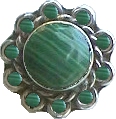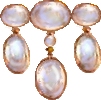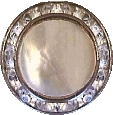
 |
 |
Rock and Mineral Dictionary |
 |
| A | B | C | D | E | F | G | H | I | J | K | L | M | N | O | P | Q | R | S | T | U | V | W | X | Y | Z |
maar A maar is a shallow, flat-bottomed crater that forms above a diatreme (volcanic vent) when steam explodes. Maars range in size from 200 to 6,500 feet in diameter and from 30 to 650 feet deep. Maars often fill with water and form lakes. |
mafic Mafic refers to dark-colored igneous rock or magma that have significant amounts of iron and magnesium. For example, olivine, augite, and hypersthene are mafic rocks. |
magma Magma is molten rock (lava) from which igneous rock forms. Magma is be formed from many types of rocks, including basalt, andesite, dacite, gabbro, and rhyolite |
magnetite Magnetite is a black to gray opaque magnetic mineral composed of iron and oxygen (it is magnetic iron ore). Magnetite is found worldwide. Magnetite, Fe3+2Fe2+O4, has a hardness of 5.5-6 and a specific gravity of 5.1 - 5.2. The streak is black. |
 mahogany obsidian Mahogany Obsidian (also called Apache tears) is brownish obsidian. This glassy, lustrous mineral is found in lava flows, and obsidian stones can be massive. Obsidian is formed when viscous lava (from volcanos) cools rapidly. Most obsidian is 70 percent silica. Obsidian has a hardness of 5 and a specific gravity of 2.35. The pin above is Mahogany (brown) obsidian. |
 malachite Malachite is an opaque semi-precious stone with layers of deep green and light green. It is usually found in copper mines; malachite is about 57% copper. Malachite was used as jewelry thousands of years ago by the ancients Egyptians. Malachite is usually cabochon set in silver. Russian malachite carvings were done in miniature and in large scale; malachite was also inlaid in furniture. Malachite has a hardness of 4 and a specific gravity of 3.80. It is monoclinic; it has one two-fold axis of symmetry. Malachite is sometimes coated with colorless wax, oil, or hardening agents to increase its durability and enhance its appearance. |
malleable Malleable metals are easily worked with a hammer or a roller. gold and sterling silver are very malleable metals. |
mantle The mantle is the layer of the Earth located between the crust and the molten core. |
marble Marble is a metamorphic rock. |
 marcasite Marcasite is a shiny, metallic semi-precious stone. It is actually iron pyrite. Marcasite is generally faceted. The Czech pin above is studded with marcasites. |
mass extinction Mass extinction is the process in which huge numbers of species die out suddenly. The dinosaurs (and many other species) went extinct during the K-T extinction, which was probably caused by an asteroid colliding with the Earth. |
maw-sit-sit Maw-sit-sit is a rare green gemstone that has dark-green to black veining; it sometimes has white spots. The stone is opaque to translucent. Maw-sit-sit has a hardness of 6.0; the specific gravity is 2.5 to 3.5. This stone is found in Maw-sit-sit, Myanmar (Burma), and is often found neat jadeite, but maw-sit-sit is not a type of jade. Maw-sit-sit was first identified in 1963 by the Swiss Gemologist Eduard Gübelin; the local called the stone maw-sit-sit, and the name was retained. Although its exact composition is still unknown, Maw-sit-sit is composed of chromite, ureyite, chrome jadeite, symplektite, chrome amphibole, and other lighter minerals. |
melee A melee is a small diamond, under .20 carat. |
mesa A mesa is a land formation that has a flat area onthe top and steep walls - mesas usually occur in dry areas. |
The Mesozoic Era ("The Age of Reptiles"), occurred from 245-65 million years ago. It is divided into the Triassic, Jurassic, and Cretaceous periods. Dinosaurs, mammals, and flowering plants evolved during the Mesozoic, and Pangaea broke up. The era ended with the K-T mass extinction. |
metamorphic rock Metamorphic rocks are compacted by pressure and heat from deep inside the earth. |
meteor A meteor is a meteoroid that has entered the Earth's atmosphere, usually making a fiery trail as it falls. It is sometimes called a shooting star. Most burn up before hitting the Earth. |
meteorite A meteorite is a meteor that has fallen to Earth. Meteorites are either stone, iron, or stony-iron. |
meteoroid Meteoroids are tiny stones or pieces of metal that travel through space. |
Mexican diamond Mexican diamond is a misleading term for rock crystal, and not a diamond at all. |
Mexican jade Mexican jade is a misleading term for dyed stalagmitic calcite; it is not jade. |
mica Mica is a soft, lightweight, transparent mineral that cleaves into thin, elastic sheets (it has a single perfect cleavage direction). It is used for lampshades and electrical insulators. There are about 30 different types of micas, ranging in color from yellow to green to gray to violet to white to brown. Mica has a hardness of 2.5 and a specific density of about 3. Tiny mica particles give the shimmer to aventurine (goldstone). |
microcrystalline Microcrystalline is a type of mineral structure in which the crystals are so small that they can only be seen using a microscope. |
micron A micron is a unit of length equal to 0.001 mm (millimeter). |
milk and honey effect The milk and honey effect is one in which the apparent coloring of a stone changes (from milky to the color of honey) as the angle of the light changes. When a light is shined on the stone, one side of the stone is the color of milk and the other is the color of honey. When the light changes direction, the color effect also shifts. Cat's-eye chrysoberyl can exhibit this milk and honey phenomenon. |
1,000,000 million A million is a thousand thousand. The dinosaurs lived millions of years ago. |
mineral A mineral is a naturally-occurring solid of definite chemical composition whose atoms usually form a regular pattern. About 4,000 different types of minerals have been identified. Each mineral has a unique chemical makeup and structure, and can be identified by its physical, structural, and optical properties (like its location, color, luster, streak, hardness, specific gravity, translucency and refraction of light). |
| Miocene epoch The Miocene epoch was a geologic time span that lasted from 24 million to 5 million years ago. During the Miocene, modern birds and many mammals evolved (including the horses, dogs, bears, South American monkeys, and apes in southern Europe). Ramapithecus appeared; this primate was pehaps an ancestor of man. The climate was relatively warm (as compared to the earlier Oligocene or the later Pliocene). There were extensive grasslands (and grasses diversified), and the interior of the continents were relatively dry; northern coniferous forests expanded. Kelp forests appeared in the seas. In North America, the Sierra Nevada Mountains and the Cascade Mountains were formed; in the South America, the Andes Mountains arose. The Bering land bridge formed during the Miocene, connecting Russia and Alaska, allowing many animals to migrat across continents. The Isthmus of Panama also formed during this time. Australia became very dry (but went through wet and dry periods). In Europe, the Mediterranean Sea and Indian Ocean were separated (they had been connected by the Tethys Sea). |
mogul emeralds These Indian emeralds were owned by Indian moguls (like Shah Jahan, the builder of the Taj Mahal) and were inscribed with sacred blessings. |
Mohorovicic, Andrija Andrija Mohorovicic (1857 - 1936) was a Yugoslavian geophysicist. After examining seismic waves from the 1909 Kulpa Valley earthquake, Mohorovicic theorized that a boundary between the Earth's crust and the upper mantle existed (about 50 km beneath the surface) in which the speed of earthquake waves became very rapid. This region is now called the Mohorovicic discontinuity. A crater on the dark side of the moon was also named for Mohorovicic. |
Mohorovicic discontinuity The Mohorovicic discontinuity separates the crust and the upper mantle of the Earth. |
Mohs scale The Mohs Scale of Hardness measures a substance's hardness, that is, how resistant it is to being scratched. In the Mohs scale, which ranges from 1 to 10, one substance is harder than another if it can scratch it. For example, a diamond (hardness = 10) will scratch garnet (hardness = 6.5-7.5), but not the other way around, so a diamond is harder than garnet. This scale was invented by Austrian mineralogist Friedrich Mohs (1773-1839). |
Moissanite Moissanite is a very hard mineral that was discovered by Dr. Ferdinand Henri Moissan (1852-1907), a French chemist and Nobel Prize winner (Moissan did work on synthesizing diamonds and discovered carborundum in 1891). He found tiny amounts of Moissanite in the iron meteorite that was found at Diablo Canyon (also called Meteor Crater) in Arizona, USA. Moissanite ranges in color from colorless to blue to green to yellow. Its chemical makeup is Silicon Carbide (SiC); it is also called Carborundum. Moisannite crystals are transparent to translucent. Moissanite has a hardness of 9.25 (this is almost as hard as diamond) and a specific gravity of 3.1 - 3.2. Laboratory-grown Moissanite is sold as a gemstone. |
moldavite Moldavite is a rare, glassy, translucent, dark green gemstone. Moldavite is a silica-based tektite, a mineral formed when a meteorite (a rock from space) struck the Earth's surface and melted and fused the surrounding rock. Moldavite is only found in Bohemia (the Czech Republic) in the Ries Crater in the Moldau River valley (which it was named for). Moldavite was discovered in the late 1800's; the meteorite from which it formed hit the Earth about 14.7 million years ago. Moldavite has a hardness of 5.5-6.6. Inclusions of gas bubbles and iron/nickel spherules are common. This natural glass has been used for jewelry, religious articles, and decorative objects since prehistoric times. |
monoclinic Monoclinic minerals have a crystalline structure in which there is one two-fold axis of symmetry. Jade, Malachite, orthoclase, and moonstone are monoclinic. |
monogenetic volcano A monogenetic volcano is one that was formed during a relatively short time period and during a single eruption. Most monogenetic volcanos are basaltic. |
Montana ruby A Montana ruby is actually a pyrope garnet (and not a ruby at all). |
 moonstone Moonstone (orthoclase) is a semi-translucent stone that is made of albite and orthoclase feldspar. It is usually whitish-blue, but can be colorless, yellow, orange, gray, or even reddish. Moonstone is usually set as a cabochon. Moonstone was very popular early in the 20th century and was extensively used in Art Nouveau jewelry. Moonstone has a hardness of 6 and a specific gravity of 2.57. It is monoclinic; it has one two-fold axis of symmetry. Adularia is a common type of moonstone. Oligoclase is another type of moonstone; Labradorite and albite are rare forms. |
morganite Morganite is a transparent to translucent pink gemstone. It is a variety of beryl, Be3Al2(Si6O18) that contains some manganese (giving the stone its pink color). Morganite has a hardness of 7.5 - 8 and a specific gravity of 2.71 - 2.90. It has poor cleavage and is brittle. Morganite is often heat treated to give the stone a purer pink color (and remove any yellow spots). Morganite was named for J. Pierpoint Morgan, the American industrialist and gem collector. Morganite is found in Brazil, Madagascar, Italy, Pakistan, Mozambique, Namibia, Zimbabwe, and the USA (California, Maine, Connecticut, and North Carolina). |
moss agate Moss agate (also called Mocha stone in Britain and the USA) is a green variety of agate. It is chalcedony that has dendritic (tree-like) inclusions of green (red or black) hornblende. The inclusions often form beautiful patterns. Moss agate has a hardness of 6.5-7 and a specific gravity of 2.6. Green moss agate is found in India, and some other locations. |
 mother-of-pearl Mother-of-pearl is the iridescent coating on the inside of oyster shells. Mother-of-pearl is used for jewelry, buttons, and other uses. |
moukaite Moukaite is a semi-precious gemstone, a variety of jasper from Australia. The color of moukaite varies from red-browns to pinks, with gold and white bands. |
mountain A mountain is a very tall high, natural place on Earth - higher than a hill. The tallest mountain on Earth is Mt. Everest. |
mudflow A mudflow (also called a debris flow or lahar) is a moving mixture of rock, water, and other debris. |
| 1,000,000 mya "mya" stands for millions of years ago. |
mya yay Mya yay is the Burmese (Myanmar) name for the highest quality translucent jadeite. |
 mystic fire Mystic fire (also called mystic topaz or rainbow topaz) is topaz that has been color enhanced by coating it with a fine layer of metal atoms (in a process called vacuum deposition). This stone has red, green, violet, and blue streaks. Mystic fire has a hardness of 8. |
 |
Rock and Mineral Dictionary |
 |
| A | B | C | D | E | F | G | H | I | J | K | L | M | N | O | P | Q | R | S | T | U | V | W | X | Y | Z |
Enchanted Learning®
Over 35,000 Web Pages
Sample Pages for Prospective Subscribers, or click below
|
Overview of Site What's New Enchanted Learning Home Monthly Activity Calendar Books to Print Site Index K-3 Crafts K-3 Themes Little Explorers Picture dictionary PreK/K Activities Rebus Rhymes Stories Writing Cloze Activities Essay Topics Newspaper Writing Activities Parts of Speech Fiction The Test of Time
|
Biology Animal Printouts Biology Label Printouts Biomes Birds Butterflies Dinosaurs Food Chain Human Anatomy Mammals Plants Rainforests Sharks Whales Physical Sciences: K-12 Astronomy The Earth Geology Hurricanes Landforms Oceans Tsunami Volcano |
Languages Dutch French German Italian Japanese (Romaji) Portuguese Spanish Swedish Geography/History Explorers Flags Geography Inventors US History Other Topics Art and Artists Calendars College Finder Crafts Graphic Organizers Label Me! Printouts Math Music Word Wheels |
Click to read our Privacy Policy
| Search the Enchanted Learning website for: |